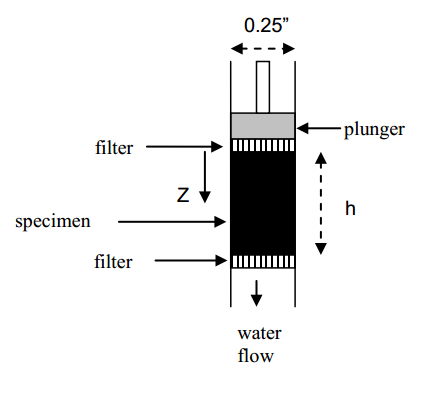![]() Properties of Brain Tissue
Properties of Brain Tissue
PI: Dr. Henry Haslach
Brain tissue is composed of water and solid phases. This internal water is in addition to the water in the cerebrospinal fluid surrounding the brain. The material properties and the model chosen must account for the water content. The different types of brain tissue include the homogeneous grey matter, the fibered white matter, blood vessels, and connecting material. Initially, the behavior of grey and white matter separately and also at their interface are studied to produce a nonlinear viscoelastic (time-dependent) model.
The internal water content of the tissue strongly affects the mechanical response. The moisture content of a rat brain was determined by freezing it and then creating a vacuum in the chamber so that all the water sublimates from the tissue. The moisture content was measured as 81% by weight, proving that the flow of water through the tissue pores cannot be neglected in the mechanical response.
The three key loads on the brain under a pressure impulse are compression, shear and tension. The compressive behavior controls the flow of water in the tissue. The flow depends on the permeability coefficient, which in turn depends on the compressive deformation that tends to close pores. No one has yet investigated the role that a sudden water flow within the tissue in response to a pressure impulse might have on TBI. The shearing is believed to be a major cause of cell rupture and connective tissue rupture in the primary impulse event in TBI. Secondary effects due to biochemistry are studied by others.
Confined compression tests of a material compressed in a cylinder to prevent lateral deformation have been conducted on a specially designed and built fixture in which the cylinder has diameter 0.25 inch. Loads less than 125 grams occur up to the 20% strain at which damage is believed to begin. Because the load is so small, friction must be nearly eliminated in the fixture. A new differential equation analysis describes the deformation due to unsteady fluid flow in the tissue. A new, complex computer program extracts the permeability and other unsteady parameters from the data using several numerical methods in combination.
A shear fixture has been designed to apply a lateral shear, rather than a twist shear, that can shear thin rectangular specimens as small of 0.5 mm on a side. The lateral type of shear is expected in the brain tissue during the primary TBI impulse. The small size is necessary for specimens of either purely white or purely grey rat brain tissue.
To reduce the number of frequencies at which tests must performed and so to simplify the experimental effort, the frequencies occurring in a typical blast pressure wave have been identified by a harmonic wavelet analysis that shows not only the important frequencies but the time at which they contribute to the impulse signal. Each wavelet has a peak at its center time and then drops rapidly to zero with a rate of decay inversely proportional to time. This decomposition contrasts to a Fourier frequency analysis that is only valid for a stationary wave over all time.

Confined Compression apparatus

